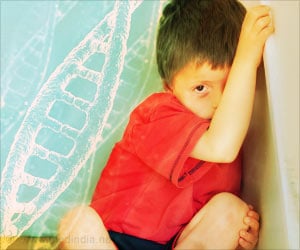The way young babies laugh is similar to chimps and this changes as the baby develops to resemble adult human laughter, finds study
Highlights:
- Young babies laugh during both inhalation and exhalation, similar to chimps but this changes as the baby develops to resemble adult human laughter which occurs mainly during exhalation
- Analyzing the laughter pattern and other non-verbal forms of showing emotion may help identify babies at risk of developmental disorders
Read More..
How do Babies Laugh?
- Sauter and her colleagues studied laughter clips of 44 infants and children between 3 and 18 months of age. The recordings were obtained from online videos captured while the babies were interacting playfully
- The recordings were analyzed by 102 listeners, drawn from across psychology students, who determined the degree to which the laughter in each clip was produced during inhalation versus exhalation
- The study found that the youngest babies at around three months of age laughed during both inhalation and exhalation, similar to non-human primates such as chimps. However, older babies laughed predominantly during exhalation similar to older children and adults
Sauter said, "Adult humans sometimes laugh on the inhale but the proportion is markedly different from that of infants' and chimps' laughs. We are currently checking these results against judgments by phoneticians, who are making detailed annotations of the laughter."
Further Research
- The team is also examining if there is a link between the proportion of laughter produced during inhalation and exhalation and the reasons why people laugh, which also change with age.
About Developmental Disorders
Developmental disorders, such as autism spectrum disorder and intellectual disabilities usually begin during childhood, but persist into adulthood. They can affect learning, speech development and other milestones, social interactions with others, ability to understand and think independently and can prevent children from achieving their full potential. The reasons for developmental disorders are unclear, but it is important to recognize these early so that intervention measures can be started sooner with better outcomes in the long-termSummary
Dr.Sauter in conclusion said, “I'd be interested in seeing whether our findings apply to other vocalizations than laughter. Ultimately, the research could offer insight into vocal production of children with developmental disorders.”If it is known how normally developing babies sound like, it would be interesting to study infants at risk of development disorders to find out if there are any early signs of atypical development in their nonverbal vocalizations of emotion.
References:
- Acoustical Society of America - (https://acousticalsociety.org/)
- Human babies laugh like chimpanzees - (https://tech2.org/human-babies-laugh-like-chimpanzees/)
- Early child development – Disabilities and developmental disorders - (http://www.who.int/topics/early-child-development/disability-developmental-delay/en/)
Source-Medindia











